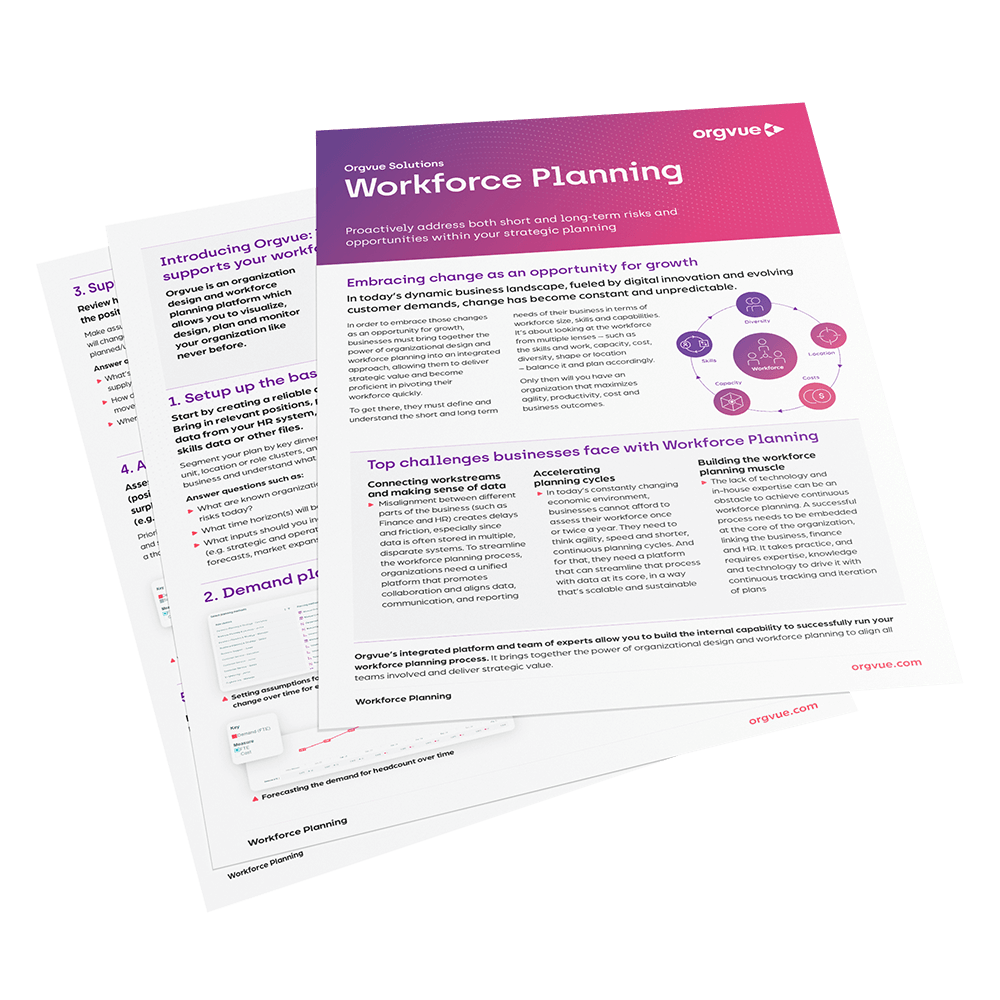
We noticed that you were redirected here from the Dynaplan website Dynaplan has recently become part of Orgvue. Click Login to access your Dynaplan account.
Why now?
Digital disruption. Customer expectations. Market shifts. Competition. The great resignation. Skills gap… the list of change drivers is long.
For today’s organizations, change is constant and unpredictable, and changing your business means changing the workforce to suit. The time has come for businesses to link their workforce to their business strategy. To think resilience, agility, and shorter planning cycles. In other words, to think continuous workforce planning.
In this ebook, we unpack some of the practicalities of adopting continuous workforce planning and shortening your planning cycles. We’ll set out the steps to a faster, data-driven workforce planning process that will position your organization to respond quickly to uncertainty and change.
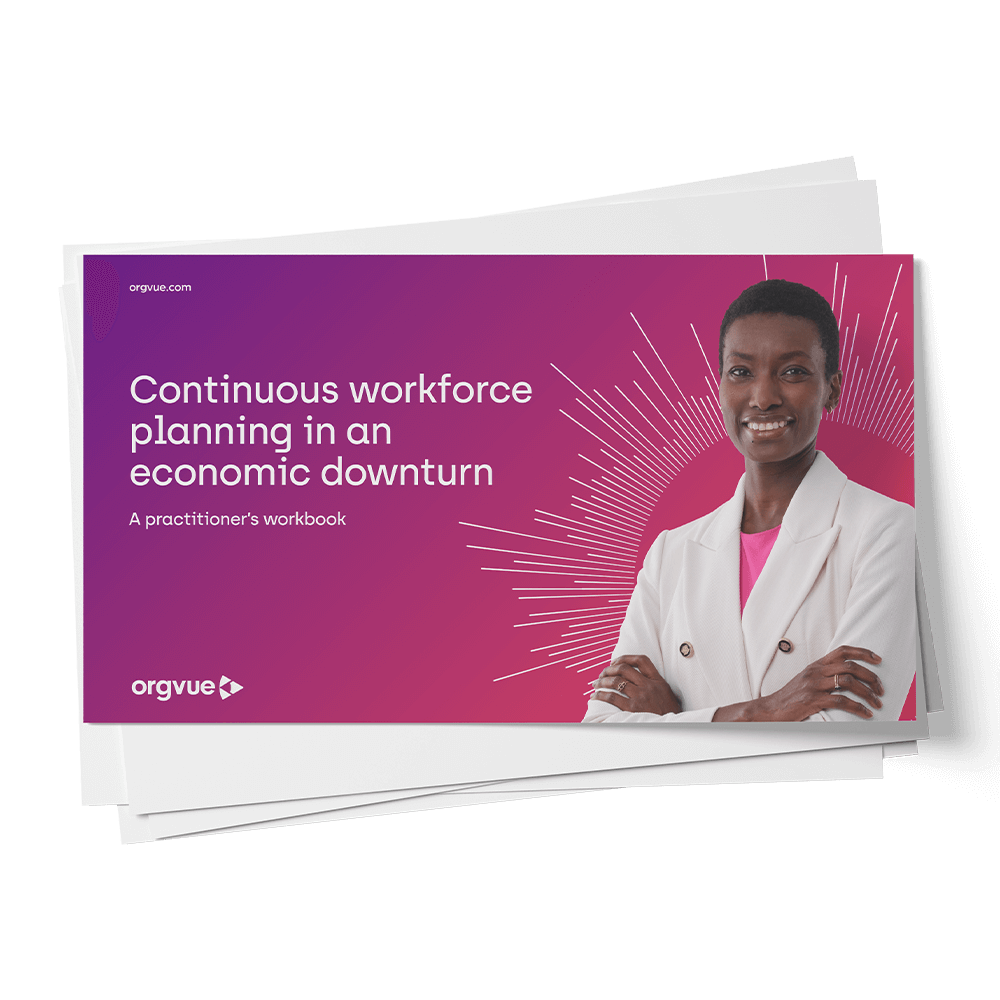
What is workforce planning?
Workforce planning is a systematic, fully integrated organizational process that involves proactively planning ahead to avoid talent surpluses or shortages. It’s based on the premise that a company can be staffed more efficiently if it forecasts its talent needs as well as the actual supply of talent that is or will be available. When executed effectively, workforce planning can enable an organization to meet its business objectives by aligning its workforce with its goals, both in the short and long term.
At its core, workforce planning involves analyzing current workforce capabilities to determine the types of skills and competencies the organization needs to meet its strategic goals. This process covers understanding the current workforce composition, identifying future workforce requirements, and then implementing strategies to bridge any gaps between the present and the future. It takes into consideration factors like demographic changes, technological advancements, and shifts in market demand that could impact the availability and necessity of certain skills.
Workforce planning is not a one-time event but an ongoing process that requires continuous attention and adjustment. It allows organizations to be agile and responsive to changes in the business environment, ensuring that they have the right people with the right skills, in the right places, at the right time. By effectively connecting strategy to people, workforce planning facilitates collaboration across teams, cultivating a unified approach to achieving the organization’s vision.
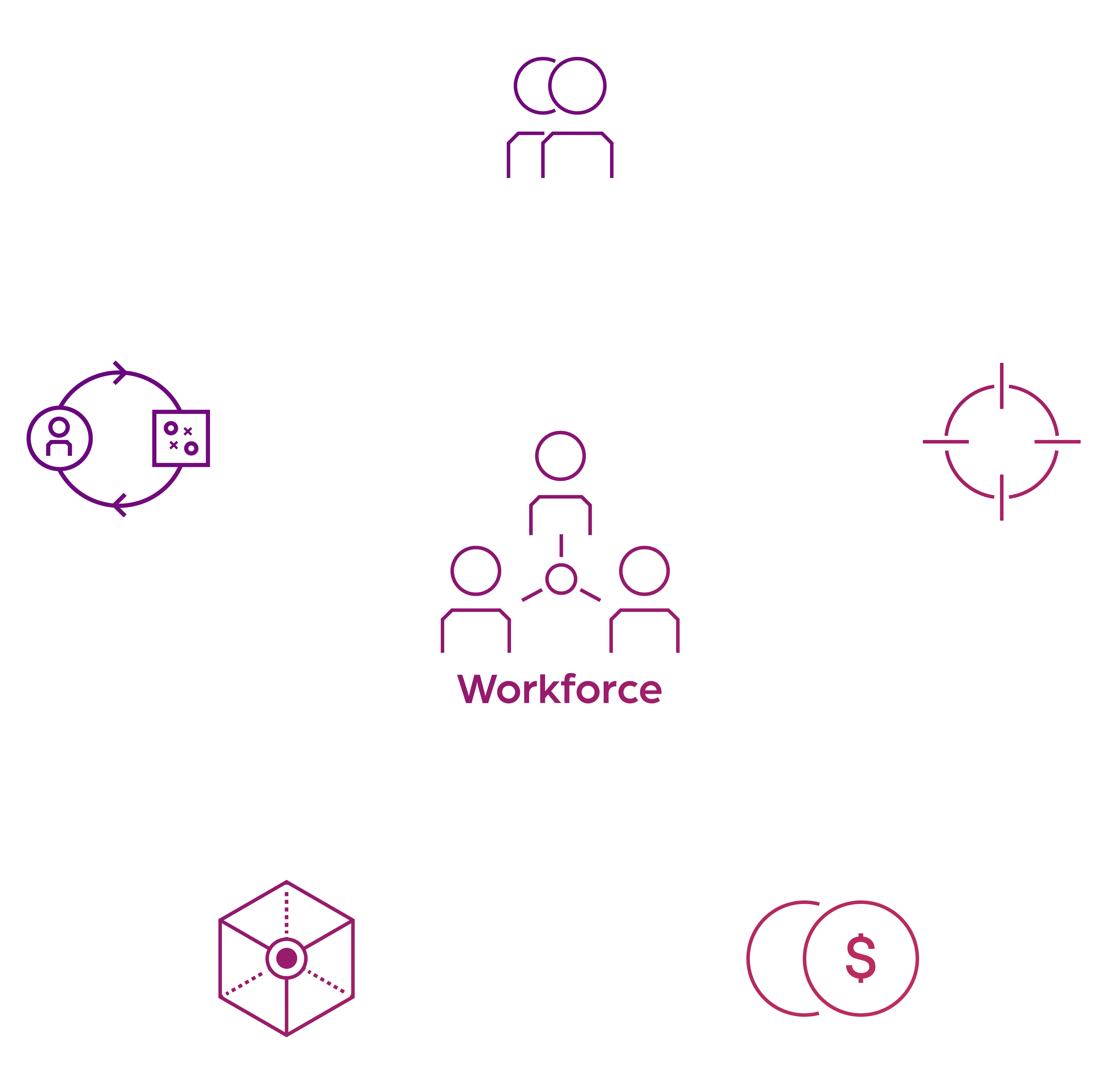
Benefits of workforce planning
Effective workforce planning drives productivity
Studies have shown that effective workforce planning can double productivity. But what exactly do we mean by ‘effective workforce planning’ and what does it include?
- A process that aligns the deployment of your workforce to deliver strategic business goals
- A planning baseline that segments the workforce into key organizational dimensions and understands current cost and headcount
- The ability to instantly identify gaps between workforce supply and demand over time
- The ability to model and assign the right people with the right skills to appropriate work
- Continuous monitoring of progress against both the workforce and business plan, and the ability to course correct as things change
Good workforce planning enhances employee engagement and satisfaction
Workforce planning done well not only focuses on the numbers but also on the human aspects of an organization. By making sure employees are placed in roles that match their skills and aspirations, and by providing clear career pathways and development opportunities, organizations can significantly boost employee engagement and job satisfaction. This approach includes:
- Tailored development programs that align with both individual career goals and organizational needs
- Strategic workforce segmentation to ensure employees are in roles where they can thrive
- Regular feedback mechanisms to align employee aspirations with organizational goals, thereby reducing turnover and increasing loyalty
Strategic workforce planning optimizes financial performance
Strategic workforce planning has a direct impact on an organization’s bottom line. By aligning workforce requirements with business demand, companies can avoid the costs associated with under or overstaffing. Effective workforce planning translates into:
- Improved labor cost management through predictive analysis of staffing needs
- Enhanced agility in financial planning, allowing for more accurate budgeting and resource allocation
- The ability to swiftly adapt to market changes with minimal financial disruption
Successful workforce planning facilitates innovation and competitiveness
In today’s fast-paced and ever-changing business environment, being able to innovate rapidly and efficiently is a key competitive advantage. Workforce planning plays a crucial role in creating an environment where innovation can thrive by:
- Ensuring the organization has the right mix of skills and talents to drive innovation
- Identifying future skills requirements that will be critical for emerging business opportunities and technologies
- Creating a dynamic and flexible workforce structure that supports experimentation, rapid learning, and the adoption of new ideas.
Why Orgvue?
Orgvue provides the technology foundation you need to align your workforce capacity, capability and cost to your strategy. How? By bringing together strategic workforce planning, operational workforce planning and organizational design in one continuous planning cycle.

Strategy to people
A single technology that brings together the planning needs of Finance, HR and the business

Data visibility
Overcome data challenges by creating a single source of truth to track baseline, actuals and plan at scale

Business alignment
Align your team efforts to a common vision

Secure collaboration
Minimize risk with a safe environment to model, plan, and consolidate efforts

Business agility
Today’s market is unpredictable. Adopt shorter planning cycles and the ability to pivot when needed
Find out more about Orgvue’s workforce planning software
Solution brief
Workforce planning
Read the solution brief to learn how Orgvue can help you to align your workforce to your organization’s goals with continuous workforce planning.
- Common challenges to overcome with continuous workforce planning
- 4 steps to continuous workforce planning
- A SaaS platform that changes everything
- A customer case study
Workforce planning self assessment
In only one minute see your company’s capability compared with our industry benchmark in your free report with hints, tips, and recommended next steps.
Workforce planning resources
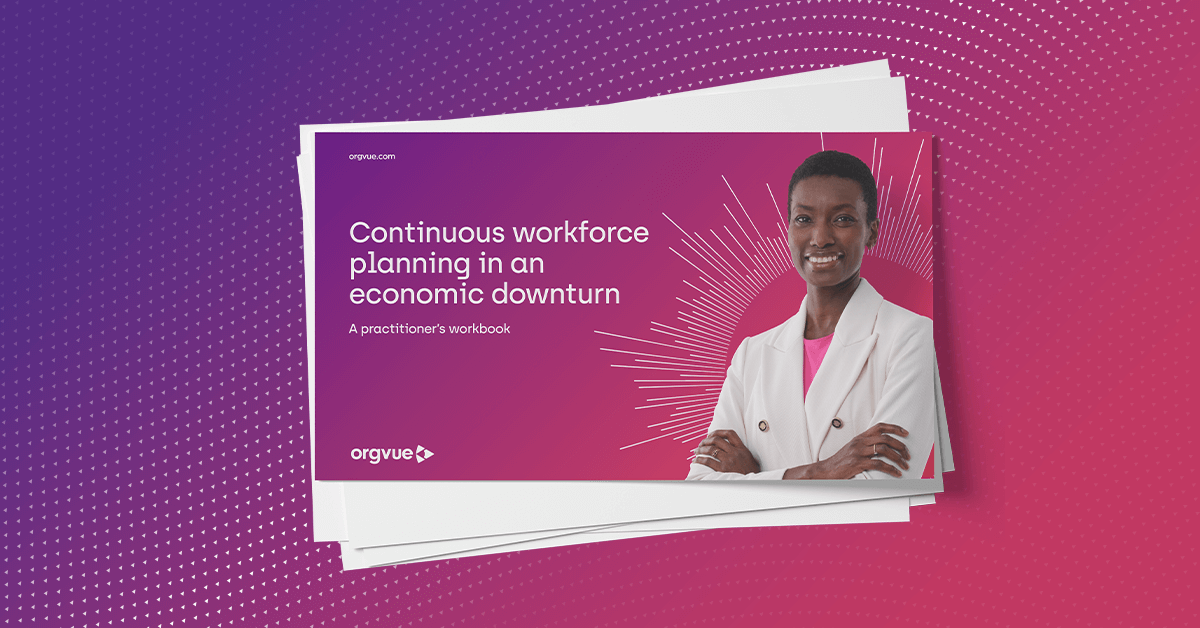
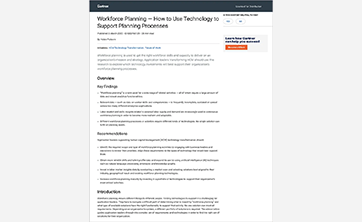
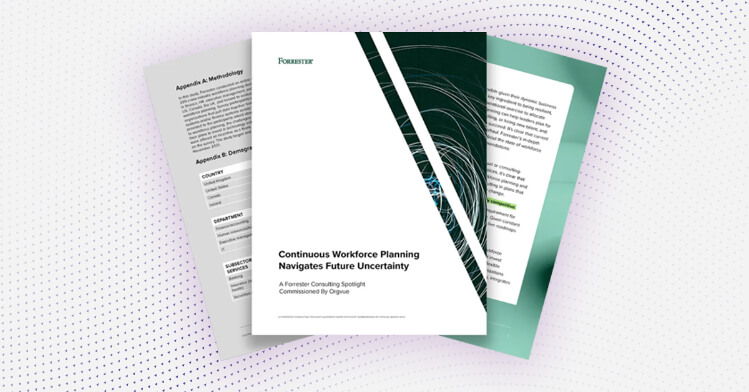


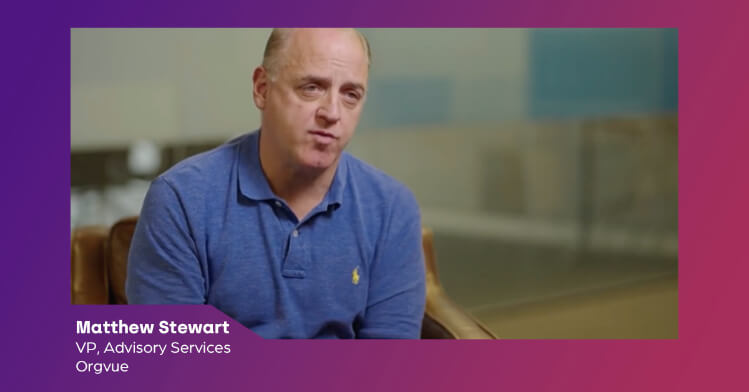
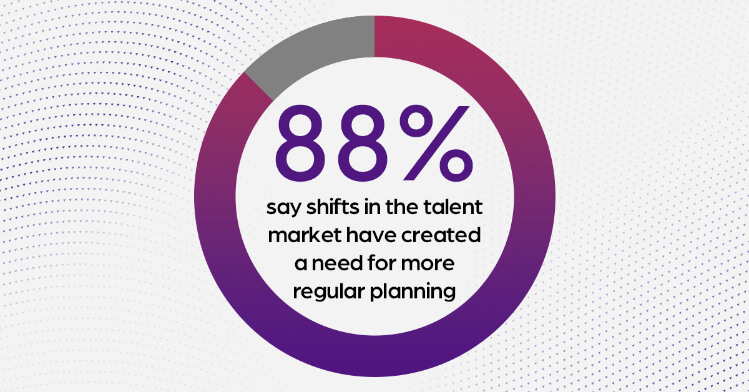

Frequently asked questions
Workforce planning typically involves five key steps:
Setting strategic direction to align workforce planning goals with organizational objectives.
Analyzing the workforce, where current skills and capabilities are assessed in view of future needs.
Developing an action plan to address the gaps between current and future workforce needs. This might include strategies for hiring, training, or restructuring.
Implementing strategies for how planned actions will be executed.
Monitoring and evaluating the outcomes against objectives and adjusting the plan as needed, based on performance metrics and changing business conditions.
Several techniques are central to effective workforce planning. Among these is gap analysis, which identifies the difference between current workforce capabilities and future needs. Scenario planning allows organizations to visualize future states of the business and develop flexible strategies to respond. Workforce analytics uses data analysis to predict trends, inform decision-making, and measure the effectiveness of workforce strategies. Lastly, demand forecasting estimates the number of employees needed to meet future business demands, considering factors like expansion plans, market trends, and technological advancements.
Workforce planning can manifest in different ways, depending on an organization’s specific needs and strategic goals. For example, a tech company might focus on upskilling its workforce to adapt to new software development technologies, ensuring its employees’ skills are current and competitive. Another example is a healthcare organization that might implement succession planning for critical roles to address the potential retirement of senior staff and ensure continuity of care. A retail chain facing seasonal fluctuations in demand could use workforce planning to optimize its mix of permanent and temporary staff throughout the year to meet customer service levels efficiently.
Strategic workforce planning involves taking a long-term view of an organization’s workforce needs based on its business strategy. It requires understanding the critical roles and skills necessary to achieve future business goals, analyzing current workforce demographics and capabilities, and forecasting future workforce requirements. This process includes identifying skill gaps, planning for succession in key positions and developing strategies for talent acquisition, development, and retention. Strategic workforce planning is proactive and focuses on making sure that the organization has the right talent in place to support its continued growth and success in a changing business environment.
Book your free demo
Design your business of tomorrow, today. Discover what Orgvue can do for your organization first-hand.
